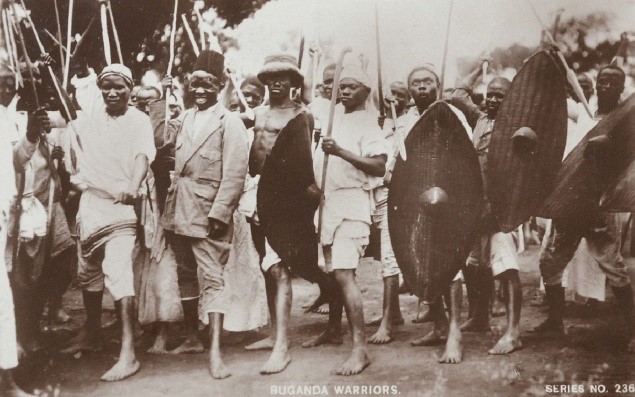Uganda Martyrs Guild
Brief History
“Here is a number of men and boys who, within a few years from first hearing the Gospel of Jesus Christ, have courage to live and die by its paradox: ‘Anyone who wants to save his life will lose it, but anyone who loses his life for my sake, will save it.’”
Bishop Joseph Willigers, Bishop of Jinja, 15th October, 1984 in the introduction to African Holocaust, The Story of the Uganda Martyrs by J.F. Faupel, Third edition, 1984.
There are 24 Catholic Uganda Martyrs. The 22 martyrs were killed between 1885 and 1887 by Kabaka (King) Mwanga of Buganda in the South of Uganda; 13 of the martyrs were burnt to death at Namugongo. The twenty-two martyrs were beatified by Pope Benedict XV on 6th June 1920 and canonized by Pope Paul VI on 18th October 1964. The other 2 martyrs were speared to death in Paimol, Gulu in the North of Uganda in October 1918. They were beatified by Pope John Paul II on 20th October 2002.
There are also Anglican martyrs that were killed by King Mwanga between 1885 and 1887 together with the Catholic martyrs. While paying tribute to the 22 Catholic martyrs Pope Paul IV also paid tribute to the Anglican martyrs in his homily at the canonisation. “And we do not wish to forget”, he said ,”the others who, belonging to the Anglican confession, met death for the name of Christ.”
All these martyrs are honoured on 3rd June every year.
The 22 Martyrs, 1885-1887
Many of the martyrs were pages in the Kabaka’s palace while others were working in chiefs’ homesteads. Each family was selecting very hardworking boys, well behaved too, to go and work for the King. It was also a sign of showing loyalty to the King as it was prestigious to work for the King.
It is in the King’s palace and chiefs homes, therefore, that the Martyrs began to learn religion after the coming of the Anglican and catholic Missionaries in 1877 and 1879 respectively. The Christian Missionaries were invited by Kabaka Muteesa I, Mwanga’s father, in his letter dated 14th April 1875 that was published in the Daily Telegraph of 15th November 1875 in England.
The first martyr to die was King’s major domo and leader of all Christians, Joseph Mukasa Balikuddembe, on 15th November 1885. He was killed because he had pleaded to King Mwanga to abandon the vice of homosexuality and not to kill Bishop Hannington, an Anglican missionary who had entered Buganda from Busoga (the backdoor of Buganda kingdom).
From that time he became angry with all Christians as they all refused to give in to his sinful demands and were persuading all other pages to do the same. On 25th May, 1886, King Mwanga ordered for a number of Christians to be brought before him and he passed on them the death penalty. 20 of the 22 martyrs were killed between 26th May 1886 and 3rd June 1886.
Some Martyrs were hacked to pieces like Andrew Kaggwa, Pontian Ngondwe, Matthias Mulumba and Denis Ssebuggwawo. Others were speared to death like Gonzaga Gonza, while others like Charles Lwanga and 12 others were burnt alive at Namugongo.
An Artist’s impression of the Holocaust at Namugongo, 3rd June 1886
John Maria Muzeeyi was the last of the 22 martyrs to be killed on 27/01/1887. He was beheaded and his body was thrown into a swamp.
The twenty-two Roman Catholics martyrs are:
Achilles Kiwanuka
Adolphus Ludigo-Mukasa
Ambrose Kibuuka
Anatoli Kiriggwajjo
Andrew Kaggwa
Antanansio Bazzekuketta
Bruno Sserunkuuma
Charles Lwanga
Denis Ssebuggwawo
Gonzaga Gonza
Gyavira
James Buuzabalyawo
John Maria Muzeeyi
Joseph Mukasa Balikuddembe
Kizito
Luka Baanabakintu
Matia Mulumba
Mbaga Tuzinde
Mugagga
Mukasa Kiriwawanvu
Noa Mawaggali
Ponsiano Ngondwe
The 2 Martyrs of Paimol, Gulu, 1918
These two martyrs, Daudi Okello and Jildo Irwa, were young catechists from Paimol, Gulu at the beginning of the 20th century. Having just received Baptism and Confirmation, they realized that to be a Christian means to share one’s faith, even at the cost of life itself, should this become necessary. So they started at once to work as catechist, and carried on until they shed their blood.
People who opposed the new religion took advantage of socio-political unrest to stop the preaching of the Gospel in Paimol. The two catechists were hounded, threatened, ordered to give up their activities, and finally speared to death. It was the week end of 18th – 20th October 1918.
Daudi and Jildo were beatified by Pope John Paul II on 20th October 2002

